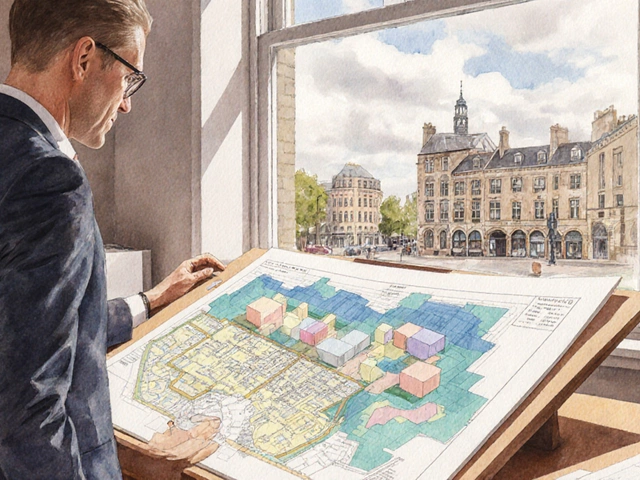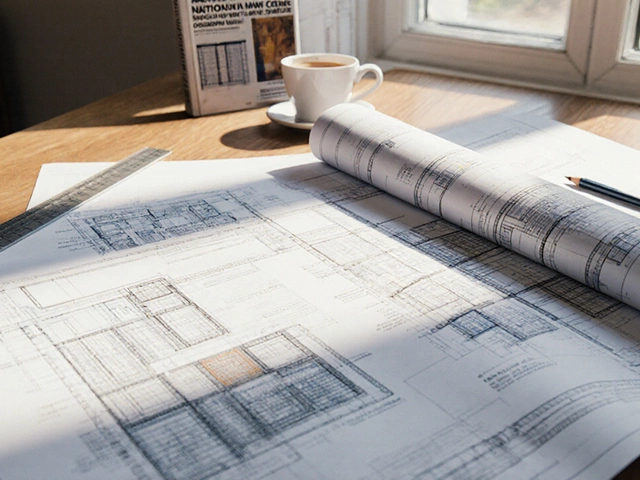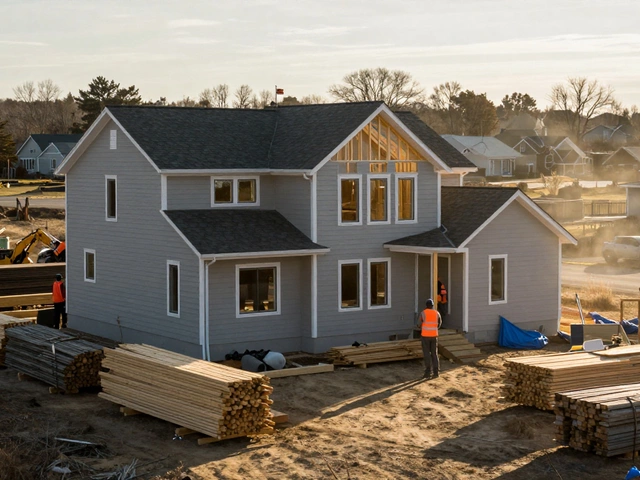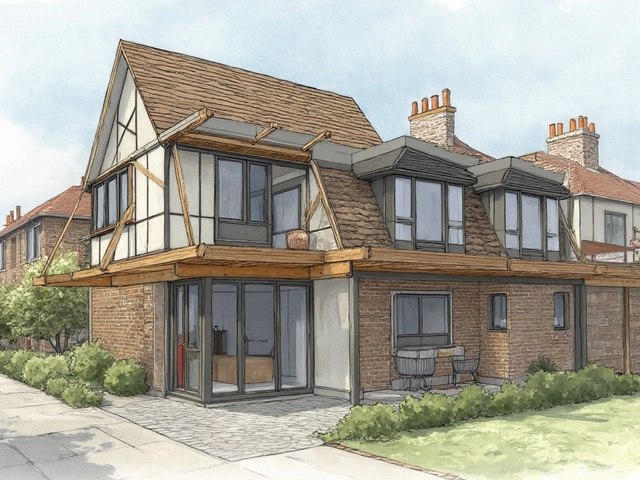Ask anyone at a crowded summer barbecue what an architect does, and you’ll get answers ranging from drawing blueprints to picking out fancy windows. The real story behind architectural services is so much more layered—and way more interesting—than most people realize. Whether you’re dreaming up your cottage, planning a commercial build, or reimagining your kitchen, architects don’t just sell 'plans.' What you get is a blend of creativity, project management, and technical know-how that can turn what seems like a pile of bricks into a place you'll love for decades.
Architectural Services Defined: The Scope Goes Far Beyond Blueprints
Architectural services aren’t just about pretty sketches or graphs. The role of an architect covers the entire journey from your first creative thoughts to the moment you unlock your new front door (and sometimes beyond). It kicks off with conversations—lots of them. You meet with an architect to hash out ideas, talk about your needs, figure out your budget, and discuss what’s possible given your site or building. The listening skills of an architect are, honestly, underrated. Experienced architects know the right questions to bring out what clients actually want, not just what they say at first.
After the first round of coffee and sketches, the architect creates 'concept designs.' This is where ideas start to become visual—drawings, sometimes 3D renderings, and models that help everyone picture the shape, light, flow, and feeling of the new space. It’s not just about looks either; things like how to catch the best sunlight (which matters hugely in a cloudy place like Halifax), or maximize energy efficiency, matter a lot at this stage. From there, detailed plans and specifications come together—and this is where things get technical.
Here’s a table for a breakdown of core architectural service stages:
| Stage | Description |
|---|---|
| Concept Design | Initial sketches, basic models, client discussions |
| Design Development | Detailed drawings, 3D studies, budgeting |
| Construction Documents | Official blueprints, specs for builders, legal paperwork |
| Bidding/Negotiation | Helping hire contractors, evaluating bids |
| Construction Administration | Site visits, problem-solving, ensuring plans are followed |
Thing is, many people assume architects vanish after handing over the plans, but that misses half the story. Good architects keep tabs during the building process, making site visits, managing changes, and often sorting out headaches before you even notice them. They act like your guide, or sometimes your shield, dealing with authorities and contractors so you don’t have to.
Now, why hire a licensed professional instead of just going DIY with a home designer? For one, architects are trained under strict standards—10 years of university and internships aren’t unheard of. They carry liability insurance (which matters if something goes sideways), and their plans are stamped to prove they meet all code requirements, which most cities (including Halifax) pretty much demand for anything substantial. Bottom line: you’re not just buying a 'drawing,' you’re buying peace of mind, safety, and someone to help the process from start to finish.
Real-World Impact: Why Architectural Services Matter More Than You Think
It’s tempting to think that a good set of architectural plans is just a formality before you let the construction crew rip into the old kitchen or pour a new foundation. The reality is that thoughtful architectural services can change your life in a bunch of ways—some obvious, some almost hidden in the details. Want a house that’s flooded with natural light in the dead of a Canadian winter? That takes planning daylighting strategies from the start. Feel like saving on heating bills forever? A competent architect bakes in passive solar design, airtightness, and top-notch insulation choices before anyone picks up a hammer.
On the commercial side, the stakes get even higher. A single design flaw in a retail store’s layout can choke off sales by messing with foot traffic. Hospitals or schools measure safety, accessibility, and function by inches—and architects sweat those little details because they matter for everyone’s experience every day. Architects also help clients navigate the complex web of zoning regulations, site surveys, and permits, translating legalese into plain language and moving projects along before bureaucracy kills the momentum.
Here’s something that always surprises folks: great design doesn’t necessarily cost more. A study done by the American Institute of Architects found that spending five to seven percent more on smart, holistic planning often saves clients ten to fifteen percent on construction—and even more across future repairs and utility bills. Smart layout choices, durable materials, and careful planning can prevent the need for costly fixes, change orders, or time delays.
For anyone thinking environmental sustainability is just a buzzword, you might want to know that buildings account for nearly 40% of global carbon emissions, according to the World Green Building Council. Architects drive the move toward Net Zero Energy buildings by picking the right materials, optimizing energy performance, and designing around renewable technologies. If you care about your long-term costs—or the planet’s—this stuff matters. Halifax, for example, has recently mandated more sustainable features in new developments, pushing the entire local profession to up their game.
Clients who work closely with architects often find the design process itself is a big part of the fun. You get to see how small choices (like, say, the direction of a staircase, or the size of windows in the living room) echo through the feel, comfort, and even the monthly bills of your finished project. Architects bring that experience, helping clients make decisions without feeling lost in a sea of jargon.
As architect and educator Witold Rybczynski once put it, “An architect is not just trained to design buildings, but to understand people, places, and processes. Good architecture never happens in a vacuum.”

Breaking Down Full-Service Architecture: The Steps from Idea to Move-In
So what does actually hiring an architect look like? It’s usually a step-by-step journey, with clear phases that keep both the budget and your dreams in check. The experience varies a bit depending on local rules and the scale of the project, but here’s the roadmap most architects in Canada use:
- First Meeting & Site Analysis: Architects start by visiting your site, walking the land or building, and talking through your needs, dreams, and must-haves. They scope out sunlight, views, zoning issues, and see where the real opportunities and problems are hiding.
- Concept Design: You’ll see sketches, diagrams, or even digital models. This is the time to share bold ideas and talk through big-picture goals. Clients often bring ‘wish lists’ or Pinterest boards—architects help filter and focus those ideas based on what fits the reality of the site and the rules that apply.
- Design Development: Here, the best concepts become more detailed. Floor plans grow clearer, materials and finishes start getting discussed, and rough budgets start to firm up. Software like Revit or SketchUp lets clients visualize layouts in 3D, helping you spot potential issues or opportunities early.
- Construction Documents: This is the legal, technical heart of architectural services—architects create official plans and specifications for contractors. Everything from structural layout to electrical diagrams gets spelled out, so builders have no excuses for creative improvisation.
- Permitting & Tender: Your architect preps and submits everything the city needs for permits. Once granted, they can help you find and evaluate contractors, even negotiate contracts if you want.
- Construction Administration: Once work begins, architects check in regularly, answer questions, adapt to surprises (like hidden asbestos or a rocky foundation), and make sure the work matches what was designed. This is massive for avoiding expensive rework or disputes. Remember—just because it's on paper doesn’t mean the builder always gets it right the first time.
The process might feel overwhelming, but most architects are pros at simplifying information without making clients feel dumb. Good ones have a reputation for clear communication and honest budgeting. In fact, transparent cost breakdowns have become standard in recent years—so always ask for this when you’re shopping for a designer.
Here’s a tip: Not all architects are right for every job. Some specialize in modern, high-performance homes, while others have deep experience with restoration of historic buildings or commercial fit-outs. Always check portfolios and references—most architects are glad to show you tours of completed projects or share stories from past clients. In Atlantic Canada, it’s common to interview two or three to find the right fit.
Tips and Facts for Getting the Most from Architectural Services
If you’re hiring an architect, planning ahead saves time, cash, and stress. Here are some tips worth remembering—straight from the trenches:
- Bring visuals—old plans, photos, Pinterest boards. You don’t need to know the lingo; just show what you love and hate.
- Ask about energy features early. Higher up-front costs can pay off fast. Halifax winters hit hard, so things like super-insulated walls, triple-glazed windows, and passive solar design shouldn’t be afterthoughts.
- Get clarity on fees—architects can bill by the hour, by project value, or as a fixed fee. Each has its place, so ask for examples and what’s included before you sign.
- Insist on clear communication—regular check-ins or progress reports should be standard.
- Check for insurance and licensing—especially if you’re dealing with bigger jobs. The Nova Scotia Association of Architects offers a searchable list of registered practitioners.
- Value collaboration. Great projects rarely happen when the architect works in isolation. Openness to input—both ways—makes for smarter, smoother builds.
The world of architecture is changing rapidly right now. Sustainability certifications like LEED and Passive House are common in new Canadian projects. Digital 3D models and VR walkthroughs help clients explore ideas without squinting at blueprints. Even small studios dabble in cutting-edge stuff, like importing building components or using AI to optimize energy use before the first brick is laid.
There’s a wild stat: According to a 2023 Royal Architectural Institute of Canada survey, 83% of new residential clients said the architect’s involvement during construction saved them from at least one costly change or oversight. That’s not just nitpicking—that’s real value on the ground.
Architectural services are way more than a set of plans—they’re about shaping space, experience, and often, how you live day to day. With the right expert, it’s possible to snag not just extra value, but a home or workplace that truly feels like yours. Find an architect who ‘gets’ your vision and you’ll unlock a host of hidden wins.







